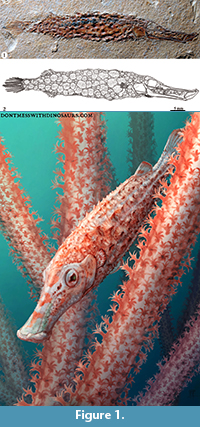Paleontologia Electronica is still number one for new open access fossil species
Article number: 20.3.5E
https://doi.org/10.26879/175E
Copyright Coquina Press, December 2017
{flike id=2093}
Andrew M. Bush. Department of Ecology and Evolutionary Biology and Center for Integrative Geosciences, University of Connecticut, 75 N. Eagleville Rd, Storrs, Connecticut 06269-3043 USA. andrew.bush@uconn.edu
Julien Louys. Australian Research Centre for Human Evolution, Environmental Futures Research Institute, Griffith University, Nathan, Queensland 4111 Australia. j.louys@griffith.edu.au
Jennifer Pattison Rumford. Palaeontologia Electronica, Texas USA. jennifer.rumford@gmail.com
Keywords: open access; DOI; trumpetfish
Bush, Andrew M., Louys, Julien, and Rumford, Jennifer Pattison, 2017. Paleontologia Electronica is still number one for new open access fossil specie. Palaeontologia Electronica 20.3.5E: 1-2. https://doi.org/10.26879/175E
palaeo-electronica.org/content/2017/2093-commentary-open-access
Copyright: December 2017 Coquina Press.
This is an open access article distributed under the terms of the Creative Commons Attribution License, which permits unrestricted use, distribution, and reproduction in any medium, provided the original author and source are credited.
creativecommons.org/licenses/by/4.0/

In 2000, Paleontologia Electronica made history as the first journal to publish descriptions of new species in electronic format (Scott et al., 2000; see history in Louys et al., 2017a). In the years since, PE has published over 300 new fossil taxa, always open access and freely accessible online.
 At the close of our twentieth year, we would like to congratulate Kleyton Magno Cantalice and Jesús Alvarado-Ortega, whose new taxon Eekaulostomus cuevasae (Figure 1) was chosen as number one on the “Top 10 Open Access Fossil Taxa of 2017” list (Farke, 2017), based on their paper published in PE (Cantalice and Alvarado-Ortega, 2016). Eekaulostomus cuevasae was selected from 45 candidates; the remainder of the top ten included dinosaurs, other vertebrates, a polychaete, and a fungus.
At the close of our twentieth year, we would like to congratulate Kleyton Magno Cantalice and Jesús Alvarado-Ortega, whose new taxon Eekaulostomus cuevasae (Figure 1) was chosen as number one on the “Top 10 Open Access Fossil Taxa of 2017” list (Farke, 2017), based on their paper published in PE (Cantalice and Alvarado-Ortega, 2016). Eekaulostomus cuevasae was selected from 45 candidates; the remainder of the top ten included dinosaurs, other vertebrates, a polychaete, and a fungus.
Eekaulostomus cuevasae is a relative of the extant trumpetfish and cornetfish, which are found in tropical and subtropical seas. It is unique in that its body is entirely covered by star-shaped scutes. It is also the oldest described member of its superfamily and the first discovered in the Americas. Modern trumpetfish and cornetfish live in coastal waters, often coral reefs, where they feed on small fish and invertebrates.
On another note, we have added DOIs to all articles from 2014 through 2017 and will continue to add them to articles from previous years. Many thanks to all those who have contributed to our Patron Program, which has made it possible to offer DOIs while keeping PE free for authors (Louys et al., 2017b). We would, of course, welcome additional donations from interested readers who would like to support our mission.
REFERENCES
Cantalice, K. M. and Alvarado-Ortega, J. 2016. Eekaulostomus cuevasae gen. and sp. nov., an ancient armored trumpetfish (Aulostomoidea) from Danian (Paleocene) marine deposits of Belisario Domínguez, Chiapas, southeastern Mexico. Palaeontologia Electronica, 19.3.53A:1-24. https://doi.org/10.26879/682
Farke, A. 2017. Top 10 open access fossil taxa of 2017. http://blogs.plos.org/paleocomm/2017/11/27/top-10-open-access-fossil-taxa-of-2017
Louys, J., Bush, A., Hagadorn, J.W., MacLeod, N., Patterson, R.T., Polly, P.D., and Rumford, J.P. 2017a. Twenty Years Online! A brief history of Palaeontologia Electronica. Palaeontologia Electronica, 20.1.1E:1-13. https://doi.org/10.26879/171E
Louys, J., Bush, A., and Rumford, J.P. 2017b. Palaeontologia Electronica needs your help! Palaeontologia Electronica, 20.2.2E:1-2. https://doi.org/10.26879/172E
Scott, D. B., Takayanagi, Y., Hasegawa, S., and Saito, T. 2000. Illustration and taxonomic reevaluation of Neogene foraminifera described from Japan. Palaeontologia Electronica, 3.2.1A:1-41. http://palaeoelectronica.org/2000_2/foram/issue2_00.htm


